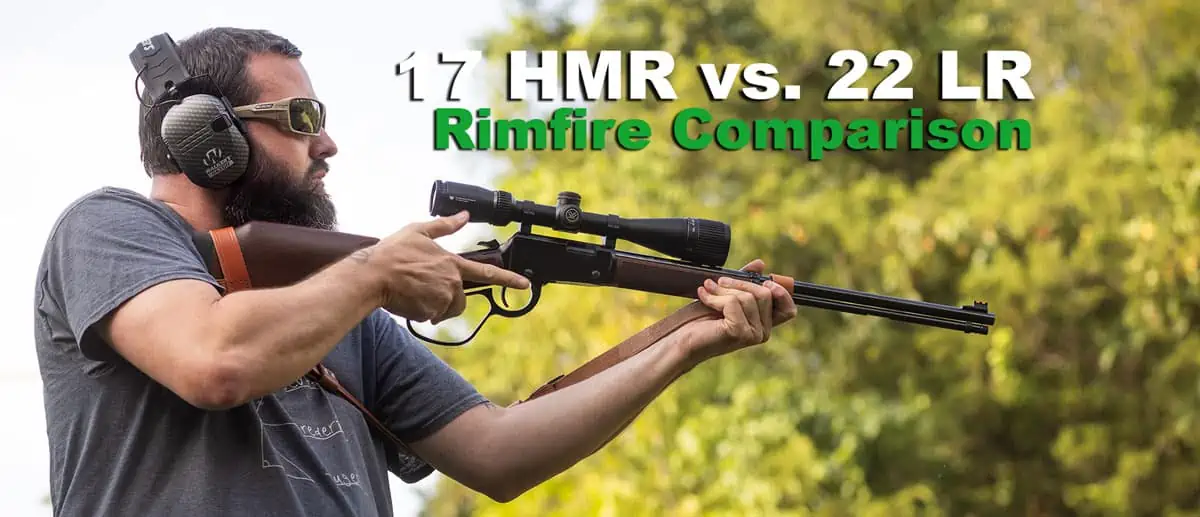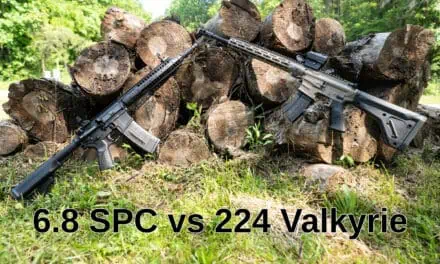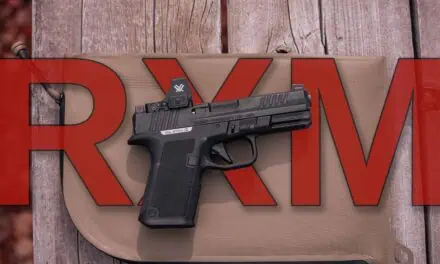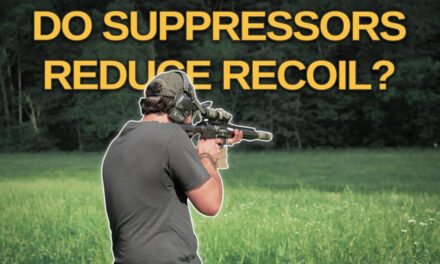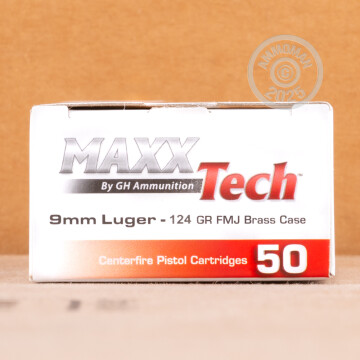22 LR is a terrific cartridge. It’s relatively inexpensive, produces minimal recoil, has enough punch for paper targets and small game, and fits an amazing variety of firearms. Since the start of my shooting days, I’ve fired more 22LR than all other calibers combined. In its match form, it can be remarkably accurate despite the use of a heeled bullet. As with the original Minié ball of the 1850s, gas pressure pushes the bottom of the bullet outward. So, the projectile adopts the conventional cylindro-spherical form by the time it leaves the barrel. With 22 LR being so amazing, what’s with all these other rimfire calibers on the market? Ok, 22 WMR sort of makes sense, being a longer and punchier 22LR with jacketed bullets. But what about 17 HMR? That cartridge has been around two decades and commands a solid niche in varmint hunting, but what’s so special about it?
Comparing 17 HMR vs 22 LR

17 HMR ammunition staggered with 22 LR rounds.
22 long rifle is a larger cartridge that’s typically loaded with heavier bullets. As a result, 17 HMR bullets fly faster from the muzzle and faster downrange – delivering more energy to the target. 17 HMR is also a flatter shooting round – meaning it doesn’t drop over distance as much as comparable 22 long rifle bullets.
Both rounds offer light recoil and shooters commonly use them to hunt small game and varmint.
17 HMR vs 22 LR – Cartridge Specs
| 17 HMR | 22 LR | |
|---|---|---|
| Parent Case | .22 WMR | 22 Long |
| Bullet Diameter | .172" | .2255" |
| Neck Diameter | .19" | - |
| Base Diameter | .238" | .226" |
| Case Length | 1.058" | .613" |
| Overall Length | 1.35" | 1" |
| Maximum Pressure | 26,107 psi | 24,000 psi |
As you can see, the cartridges are different sizes and therefore, you can’t interchange the two. In other words, you can’t fire 22 LR in a 17 HMR chambered rifle.
Assessing 22LR’s Ballistic Capabilities
The best and most accurate 22 LR loads start out as standard velocity or subsonic cartridges. Some of them, like Federal plated subsonic, weigh 45 grain. The slightly heavier bullet delivers better penetration. Here’s where nature and physics get annoying: all these amazingly accurate loads somehow fail to perform in the field. The issue isn’t ammunition — it reliably delivers MOA dispersion — but the limitations of the flight time stemming from the low initial velocity and moderate ballistic coefficient.
Take, for example, a nice 1,150 feet per second target load fired with a 50 yard zero against a 100 yard target: the bullet drop is significant 6.5″. It is significant relative to the likely rodent or bird target, but drop is at least predictable. Make a 10-yard range estimation error, and the drop is either 2 inches less or 2.5″ more.
Complications of Windage
Wind drift is less predictable; at 100 yards, even a slight 10 mph side wind causes a 6 inch windage error. Keep in mind that windage is counted from the muzzle position, not from the zero distance, since zeroing was done with no regard for wind. The trouble with windage correction is that the same bullet will be an inch closer to the point of aim just ten yards closer, and over an inch further just ten yards further. For a prairie dog standing upright, an inch of deflection can be the difference between a headshot and a haircut. What if the wind is at 30 degrees rather than 90, what if it is gusting rather than steady? Is it time to bring hypervelocity 30-grain varmint loads out? That cuts our bullet drop to mere 3.5 inches, and the wind drift actually increases to 7″. Further, the lighter bullet that goes through a destabilizing trasonic transition gets rather less accurate, so dispersion increases.
Some varmint bullets, like CCI Stinger, don’t even fit match 22 LR chambers. In short, 22 LR works pretty well for precise hits at short range. Once you reach out to 100 yards and further, even very accurate launch platforms run into the limitations imposed by external ballistics.
Looking at 17 HMR Ballistics

17 HMR ammo is a necked-down 22 WMR, with higher chamber pressure and correspondingly high muzzle velocity imparted to small, streamlined bullets. Although 17 HMR projectiles range from 17 to 20 grains, they have ballistic coefficients similar to much heavier 22 LR and 22 WMR bullets. With launch velocity of 2500-2600 feet per second (17gr) and 2300fps (20gr) respectively, 17 HMR works pretty well at 100 yards.
Bullet Drop
17 HMR’s drop from 50 to 100 is 0.75″, an extra ten yards causes only 0.5″ drop compared to 2.5″ with 22 LR.
17 HMR’s Wind drift is nearly half of the value for 22LR varmint round too. In real-world conditions with uncertain wind flow at various distances, and rodents popping up briefly at distances that can’t be lasered quickly enough, flatter trajectory and reduced wind drift mean more hits and, ultimately, less ammunition expenditure than trying to bring a hail of slower projectiles onto a briefly visible target. For longer-distance varminting, 17 HMR stays supersonic past 250 yards, keeping accuracy consistent to the end of its viable range.
Impact on Your Target

You can cycle a Henry Varmint Express lever action rifle quickly, but a varmint is unlikely to give you a second try in case of a near miss. That’s why I was pleased to discover that it approached MOA accuracy in 17 HMR. We witnessed only a minor variation between the several types of ammunition.
Instead of gelatine, I used highly visible oranges as targets for testing bullets. 22 LR bullets of various kinds bunched clean holes through the fruit. Pre-fragmented CCI bullets made three fairly thin channels. 17 HMR ballistic tips just exploded the the fruit, leaving no more than 20% of it remaining in place. Having projectiles well-matched to the velocity is the other advantage of this caliber: pretty much all the energy is used up deforming the bullet and the varmint rather than the backstop.
17 HMR vs 22 LR Pricing
 17 HMR’s price is half-way between bulk 22 LR ammo and cheaper centerfire cartridges like 223 Remington. However, comparing oranges to oranges, we get a different picture: match grade and specialized varmint 22 LR is only slightly less expensive than 17 HMR. The cost increase of 25% or so is more than compensated by the reduced round count required to get the job done. That was evident in the zeroing process: I had to fire only two shots, one to get on paper, another to adjust from the first hit. Accurate rifles with good optics — in my case Vortex Diamondback 4-12x40mm with Dead-Hold MOA reticle in 3/8″ Warne Maxima 1″ medium-height rings — make zeroing quick and easy. Just count the grid squares and click in the corrections. With minimal dispersion at 25 yards, I was done in a minute. I rechecked the results at 50 and 100 yards. 2-inch green walnut husks remained easy prey all the way out to the 110-yard backstop of my home range.
17 HMR’s price is half-way between bulk 22 LR ammo and cheaper centerfire cartridges like 223 Remington. However, comparing oranges to oranges, we get a different picture: match grade and specialized varmint 22 LR is only slightly less expensive than 17 HMR. The cost increase of 25% or so is more than compensated by the reduced round count required to get the job done. That was evident in the zeroing process: I had to fire only two shots, one to get on paper, another to adjust from the first hit. Accurate rifles with good optics — in my case Vortex Diamondback 4-12x40mm with Dead-Hold MOA reticle in 3/8″ Warne Maxima 1″ medium-height rings — make zeroing quick and easy. Just count the grid squares and click in the corrections. With minimal dispersion at 25 yards, I was done in a minute. I rechecked the results at 50 and 100 yards. 2-inch green walnut husks remained easy prey all the way out to the 110-yard backstop of my home range.
Henry makes several 17 HMR lever guns, Savage and Ruger make bolt actions. Attempts at making a reliable semi-auto 17HMR have varied in success, with some models being quite good. For paper punching and short-range speed-shooting games, 22 LR wins hands down. It’s versatile, relatively inexpensive, and reliable in a variety of actions. If self-improvement is the goal of marksmanship practice, 22 long rifle gives similar challenges at 200 yards that 308 Winchester gives at 600. If the goal is to hit fleeting creatures past 50 yards, 17 HMR is a definite winner of that bid. Give it a try.

